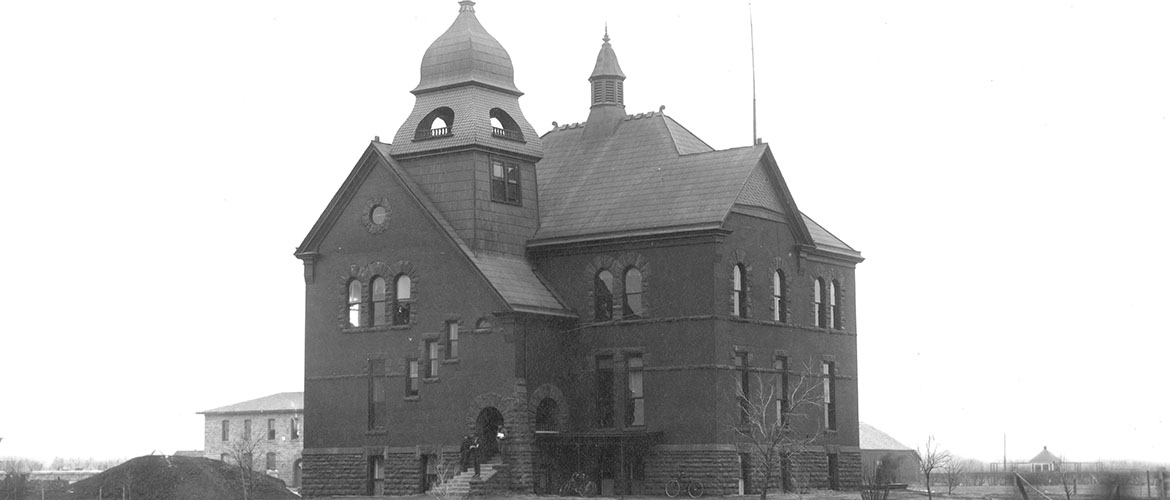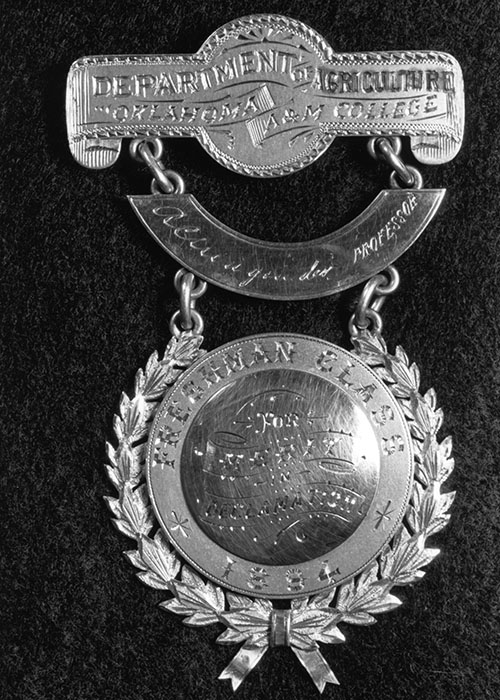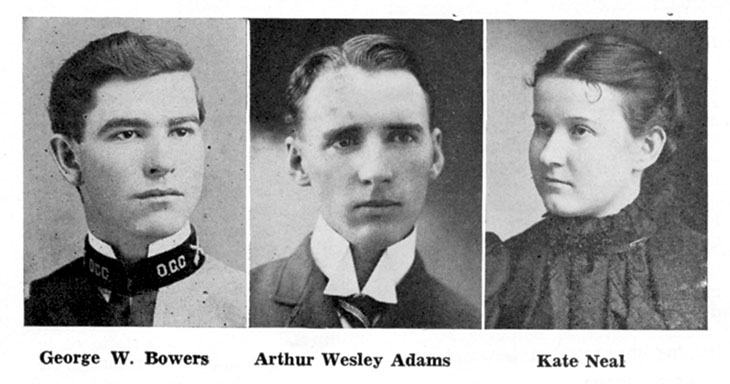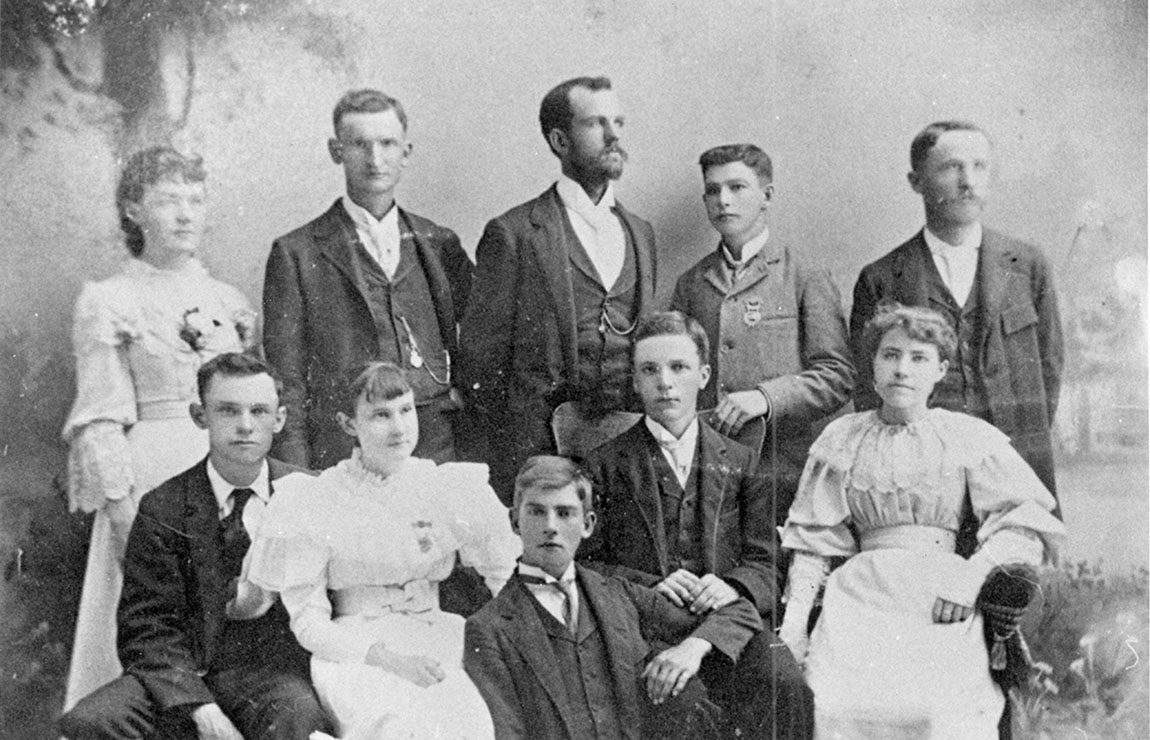
Three Gold Medallions
Thursday, August 29, 2019
Alexander C. Magruder Awards inspired OSU’s first top scholars
Oklahoma Agricultural and Mechanical College faculty member Alexander Magruder worked to motivate and encourage young minds. Most of the students enrolling at the new college in December 1891 never imagined that they would have the opportunity to acquire a university education. Few knew what to expect in a university. These young people had arrived on an open prairie near what would become Stillwater during the Land Run of 1889. Magruder was one of the first faculty members hired at the OAMC in the fall of 1891. Known as Alec Magruder, he was an excellent lecturer, admired by his students, and he helped establish a strong agricultural research station.
The region had been the traditional borderlands of the Osage and the Kiowa. Briefly a home for the Seminoles and Creeks, it was opened for homesteading families to occupy the unassigned lands at the center of the Indian Territory. It was doubtful that many envisioned a university education in their future. Local students had only limited formal educational experience, and half had not graduated from high school. The non-graduates, some as young as 13 years old enrolled in the sub-freshman preparatory program.
Inspiring these young scholars at a new college with no permanent facilities, few faculty members and limited resources would be a challenge. The first faculty members, also new arrivals, set about to implement educational standards with realistic expectations for student success. Classes started in mid-December 1891, and the first full semester ended in the spring of 1892 without fanfare. By the fall of 1892, Magruder, who was professor of agriculture and horticulture, supported the Star Crescent Literary Society. Very few details survive for this group, and it disbanded the following year, but efforts to build a community of scholars continued.
Early in the spring of 1893, college faculty members decided to hold a three-day commencement celebration to establish a routine and prepare for the day when students would graduate. Professor Magruder sponsored a contest for the freshman class the first night. During the program, a student competition in declamation was held to increase student attendance. Students selected poems or passages to recite. Six finalists were selected for the formal presentations to the public.
The first commencement celebration started Friday evening, June 16, 1893. No facilities were available on the OAMC campus, so the ceremonies took place in the new Methodist Episcopal Church-South, located about a half-mile south of the college. The sanctuary had a 250-seat capacity, which the eager crowd exceeded. Three members from the Class of 1896, Frank E. Duck, Erwin Jarrell and Kate Neal were finalists. Contest winner 15-year-old Kate Neal presented the dramatic reading “Searching for the Slain,” a poem about a mother searching for her son’s body on a battlefield. Magruder and Freeman E. Miller, a local poet and writer, judged Kate’s recitation was the best. Miller presented her with the first gold Magruder Medal “For Merit in Declamation” the following day. Miller was the newest faculty member on campus. He had been hired to serve as the College Press Bureau director and would later supervise production of the first student literary publication, The Oklahoma A.&M. College Mirror.

Kate Neal, the daughter of Oklahoma Agricultural Experiment Station Director Dr. James C. Neal and his wife Emma, had spent weeks memorizing her lines. Her younger sister Amie declared, “It had taken my sister many weeks of practice to learn that piece and having had to listen to her, I could have taken over had she forgotten her lines that fateful night.” Two years later Kate, the only remaining female in the Class of 1896, would leave college one semester shy of graduation. Her father died of a heart attack on campus in December 1895, and Emma took the two girls with her back east. Kate would not become the college’s first female graduate, but she had demonstrated that women were capable, qualified and competitive with their male counterparts in higher education.
The first commencement festivities, including the declamation contest, were both successful and popular. Efforts expanded for the 1894 events. The second class of OAMC freshmen qualified for the “best declaimer” contest with the program moved to Saturday at 10 a.m. on June 16, 1894. The new Assembly Building (Old Central), with an auditorium on the second floor, hosted the event. This building was dedicated during the 1894 commencement activities. Six finalists were selected to present memorized passages from a diverse set of sources.
This year, the program was under the direction of faculty members Frank A. Waugh and George L. Holter. Waugh had a master’s degree in horticulture from Kansas A&M, and Holter was a Penn State graduate in chemistry. Neither had an academic background in public speaking, but that did not stop them from forcing the finalists to practice for extended periods as they fine-tuned their presentations. The college orchestra performed selected pieces between sets of recitations.
The winner of the second gold Magruder Medal, George W. Bowers, described his experience: “At 10 a.m., we were all present and prepared for the ordeal. I was worried and quite nervous, but fortunately I was the first speaker. What a relief it was when I finished and could sit down and listen to my classmates, a procedure I thoroughly enjoyed. To my surprise, the judges gave me the decision, and when the medal was presented to me, I was almost speechless. All I could say was, ‘thank you.’”

The final Magruder Medal was given to the winner of “Best Oration, Junior Class, 1895.” The six finalists for the prize would eventually become the first six Oklahoma A&M College graduates the following year. For this competition, the finalists would write about an agricultural or scientific topic and present their paper to the audience. The presentations took place on a Monday evening in mid-June as part of the third annual commencement.
The evening performances began with the OAMC Orchestra followed by the first two speakers. This pattern continued with the orchestra playing another musical number, and two more speakers would present their papers.
After the last two speakers, there was a cornet solo, and the judges (Hays Hamilton, J. S. Workman and the Rev. G.W. Mowbray) left briefly to make their decision. They arrived at a unanimous decision and shared the winner’s name with Alec Magruder. According to the report in the College Mirror: “Magruder, the generous giver of the medal, made the presentation to the winner in an eloquent and pleasant speech, full of feeling and beautified with tender sentiment and good advice.” Arthur Adams won the third and last gold Magruder Medal for his presentation on the significance of electricity and the impact it would have on the future.
The College Mirror provided descriptions of each student presentation. The new literary societies, established two years earlier with Magruder’s support, published the monthly publication. The Webster Literary Society, which was all male, and the Sigma Literary Society, which was open to both genders, collaborated to produce this monthly literary magazine. It would be the predecessor of the OAMC student newspapers.
Magruder, known as “the faculty aristocrat,” designed and financed the production of the three gold medallions awarded for literary merit, supported the establishment of literary societies and was instrumental in the establishment of the first commencement ceremonies. All of these activities proved especially significant during the three years before there were any graduates when the young academic community was attempting to establish expectations for fledgling college scholars. Magruder would leave Oklahoma A&M in June 1895, but his contributions to inspire scholarship, to quality instruction in the classroom and to excellence in research remain with us today.

|
1894 MACGRUDER MEDAL CONTESTANTS |
| Left Column | Middle Column | Right Column |
|---|---|---|
|
Subject “Story of a Cyclone” “Seed Catalogs” “The Vision of Mirza” “Labor and Poverty” “A Sewing Girl’s Diary” “Story of a Battle” |
Author Anonymous L. H. Bailey Joseph Addison Carlyle Oscar Will Carleton Bob Burdette
|
Speaker George W. Bowers Andrew Nelson Caudell Jessie Olive Thatcher Clay Adams Gertrude May Diem Rawson Van Taylor |
| Panel Heading | Panel Content |
|---|---|
|
1895 MACGRUDER MEDAL CONTESTANTS |
| Left Column | Middle Column | Right Column |
|---|---|---|
|
Subject “Landscape Gardening” “Agriculture” “Plant Life” “Irrigation” “The Kitchen Garden” “Development of Electricity”
|
Author and Speaker James H. Adams Alfred E. Jarrell Frank E. Duck Erwin G. Lewis Oscar M. Morris Arthur W. Adams
|
|
